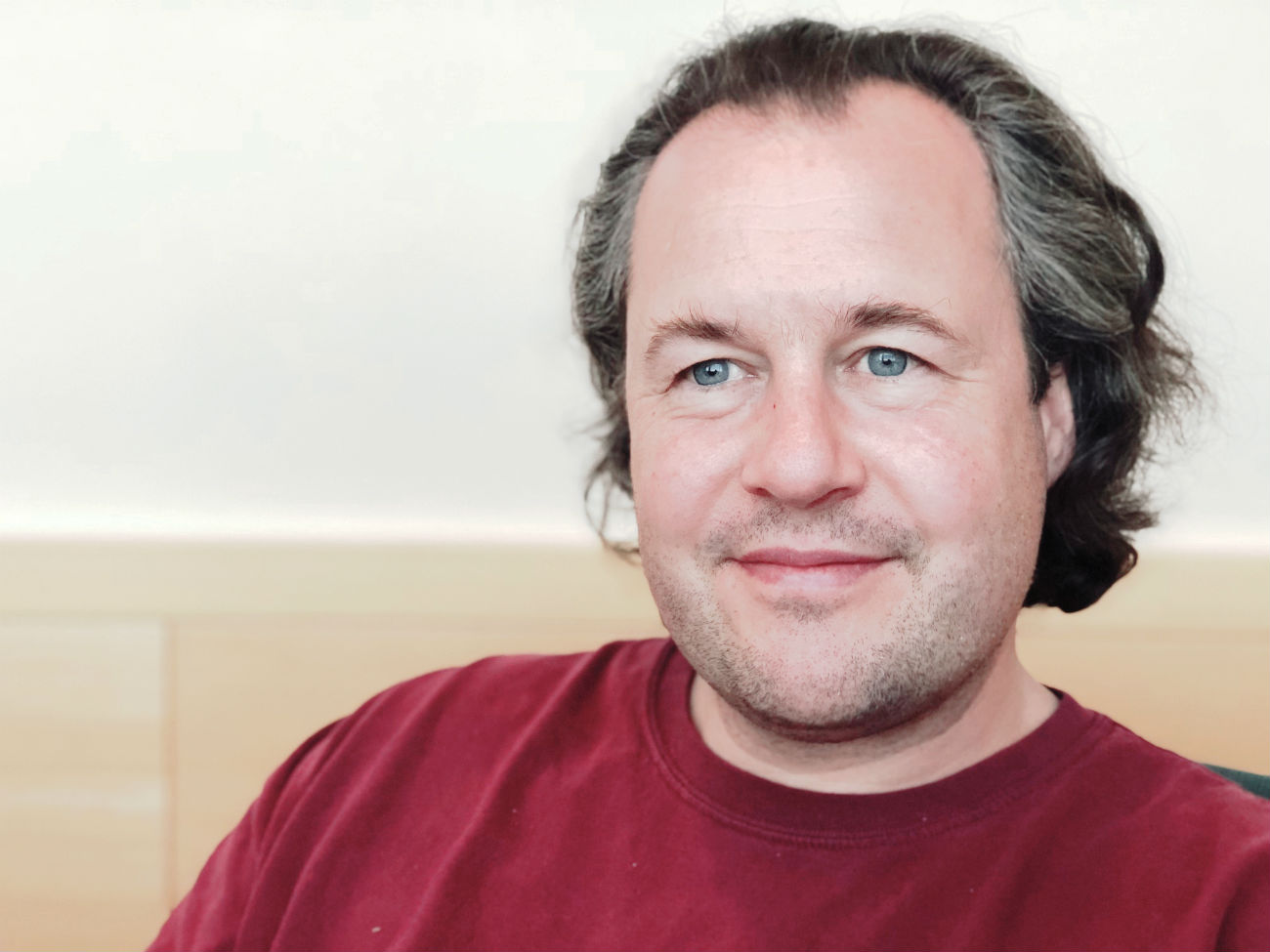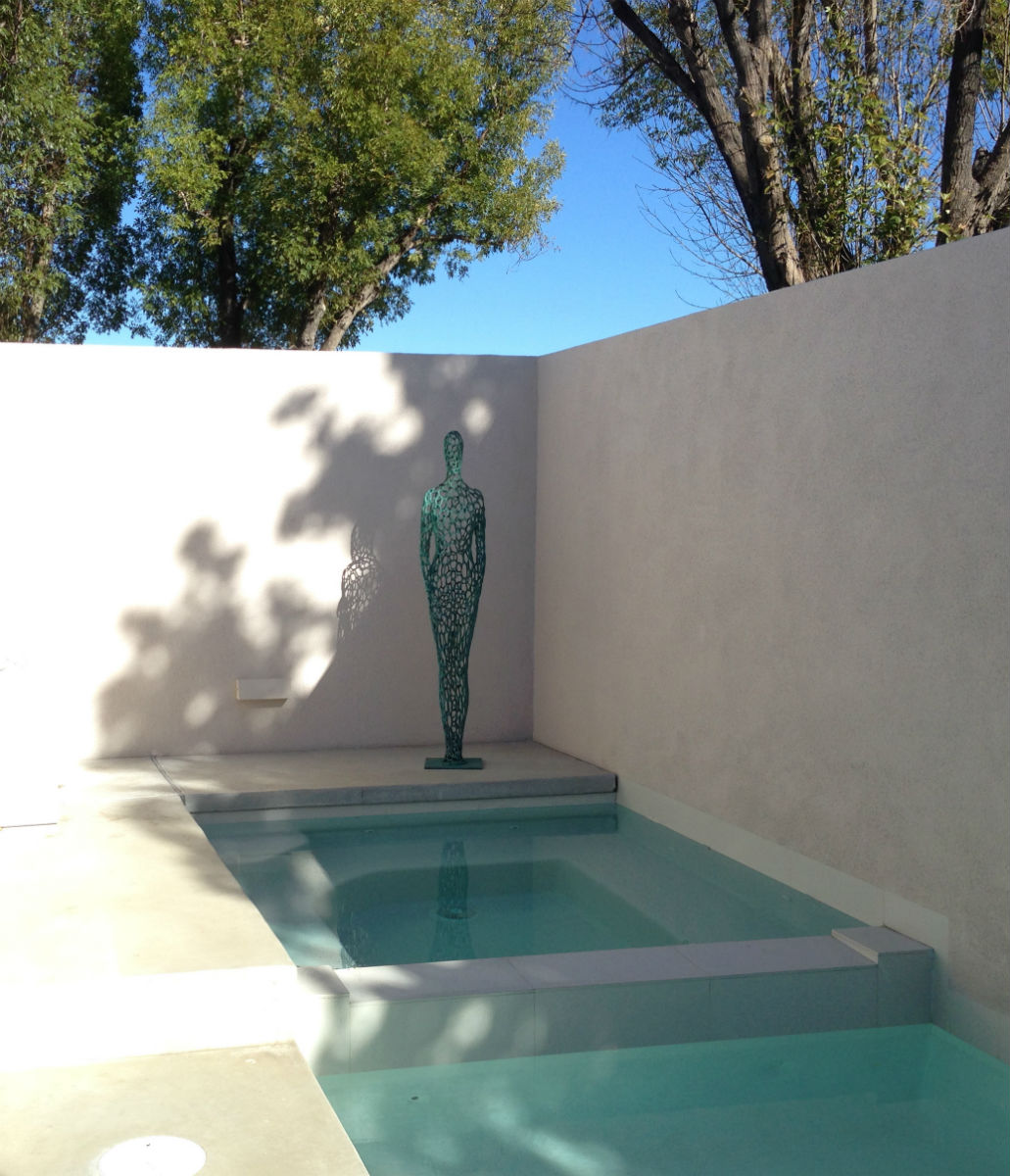
Artist Bio
Julian Voss-Andreae is a German sculptor based in Portland, Oregon. Starting out as a painter he later changed course and studied physics, mathematics, and philosophy at the Universities of Berlin, Edinburgh and Vienna. Voss-Andreae pursued his graduate research in quantum physics, participating in an experiment considered one of the modern milestones of unifying our everyday intuition with the famously bizarre world of quantum physics. He moved to the United States to study Sculpture at the Pacific Northwest College of Art from where he graduated in 2004.
Voss-Andreae’s work, often inspired by his background in science, has captured the attention of multiple institutions and collectors in the United States and abroad. Recent institutional commissions include large-scale outdoor monuments for Rutgers University, the University of Minnesota, Texas Tech University, and the Georgia Institute of Technology. Voss-Andreae’s work has been featured in print and broadcast media worldwide.

Julian Voss-Andreae Interview
You spent your childhood in Germany. How did this influence and contribute to developing your inner sensibilities? What inspired you to explore the world of art?
My parents are both deeply interested and involved in the arts. They love classical music and fine art; my mother is a devout violinist and my father has always had art projects in addition to his work as a lawyer. He once created a feature-length movie about German artist Horst Janssen and now he is working on an encyclopedia about another artist, Emil Orlik. When traveling, my parents would always visit cultural sites such as churches and museums with us children and we grew up with a sense that art is one of the most important things in life. We were always encouraged to play music and pursue artistic hobbies. I especially enjoyed drawing and pottery as a child.

Since you were a child, you have been fascinated with science. How did that that fascination grow and change in conjunction with the artist in you?
That is not actually true. In my childhood, doing art felt more natural than doing science – but in addition to my artistic hobbies I developed a taste for scientific things, as well, starting with my (at best, semi-scientific) passion for LEGO blocks, I also tried to build some electronic devices with my electronics kit. I had also assembled a pretty massive chemistry laboratory in my room. But around age 18 I was deeply into drawing and painting and decided to become an artist – presumably a painter. I moved to Berlin with the goal of attending the art academy there, but first I had to do my required community service (in lieu of the then compulsory armed service). At that time, I met a very good friend who was a poet and would later move on to study biology in a quest to fuse art with science. We enrolled together at university and took some philosophy of science classes together. In one of those I came across Roger Penrose’s book ‘The Emperor’s New Mind’ which got me hooked to the bizarre world of quantum physics. I was so intrigued that I enrolled to study physics with the explicit goal to understand quantum physics better and to be able to do the experiments myself first hand, as opposed to believing the seemingly crazy things the science writers claimed. I felt that quantum physics’ lessons are too revolutionary to believe without experiencing them myself.
During my time in physics I did almost no art because I was completely focused on my studies and tried to be as good as I could – which was a challenge since I had been a mediocre student in school. It is interesting to spend some years not being ‘creative’ – all your creative energy goes into recreating what others have found out, into making existing knowledge your own. You study and absorb the material until you feel it is fully alive inside yourself. That was an incredibly satisfying experience.


Your background in physics, mathematics, and philosophy has shaped the way you create art. Do you actively seek inspiration from other genres/forms of art?
I certainly look at sculpture, dance, listen to music. But most inspiration for me comes from science and engineering, but also from psychology and spirituality. Engaging with and observing people, my family, solving everyday problems when raising children provides me with a lot of raw material for sculptures.

What do you love most about the place you live? How do you think it influences your work?
I live in Portland, Oregon, about 90 minutes by car from the Pacific Coast. The coast is an amazing place with large empty beaches. Equally beautiful is Mount Hood and other snow-capped volcanoes at similar distances to Portland. We also have the most wonderful waterfalls in the Columbia River Gorge. I don’t get to those places nearly as often as I should! I am not sure how it influences my work, but the people here are very friendly, tolerant, and non-judgmental. In general, people in the United States are appreciative and encouraging to entrepreneurs and that has helped tremendously to start and grow my art business here.





What is the creative process that goes into bringing a sculpture to life?
If it is a commissioned piece, I usually visit the site first. The ideas that emerge, the shapes and colors, are the starting point for the development of a new sculpture. Each sculpture is connected to all the others, there is an organic evolution of concepts and ideas. The ideas get refined and the next stage is sketching by using 3-D modeling and usually some kind of mathematical manipulation. When the concept is refined, I design the piece in detail with a clear idea how it will be fabricated. Then I create the files that will become the parts, usually 3-D printed parts or laser-cut files. The last step is waiting to get the parts made and building the sculpture from them.
Can you tell us more about how you fuse technology with handcrafting?
Technology is often my inspiration and a key tool to achieve my visions. But at the end of the day it is the craft that will make things become reality and successful. Even if a sculpture is made for example by using 3-D printing, there are always hundreds of hours of intense human labor in there, labor that requires finely honed skills and complete focus on each step of the process. It is that work, both in the design process as well as in the fabrication portion, that at the end will show and make the work what it is.


What are the challenges you most often face during your work?
To juggle so many things at the same time. Hard are all the real-world challenges of running a business while staying creative. I work with employees who need to have work set up and be paid and require many other things. Then engineering challenges, how can something be designed to work outdoors, hold up to gravity, how is it going to be lit? And, of course, how do I make enough money to keep my studio running and, hopefully, earn a living? Finding galleries and art consultants, remaining a reliable partner to people who make money off my work and provide me with the connection to clients, while staying fresh and creative. And, at the same time, run a family, be a nice husband, make sure the children are taken care of. A lot of things!

Your artwork gives you the opportunity to travel. How does learning about other places and cultures nourish your artistic soul?
Moving to the US from Europe was quite a shift for me. I recalibrated a lot of (implicit) assumptions. The most fascinating for me is always to connect with people and observe them. As I am writing this, I am in Italy, one of my favorite places – I also met my wife and made my first sculpture here. I was looking at the ancient architecture here in Siena today, and it is incredibly inspiring.


Who is your favorite musician or band? Do they inspire your creativity?
I do listen to music in the car for example but almost never when I work. The same is true when I was in science; there are people who solve their equations with music but that was never for me. I am most deeply touched by classical music; Bach, Mozart, Schubert, Beethoven, and others.


What is your dream creative project?
I am working on a fascinating project right now. I am designing four very different sculptures all for a private residence in Los Angeles. Each location is completely different, and each sculpture is going to be very different. It is so fun to come up with pieces that relate to each other as opposed to a singular sculpture, it really opens new possibilities and triggers new ideas. I had a similar project, two years ago also for a private residence, where I created two sculptures, one inside and one outside. Both are clearly related yet very different.
I have an old dream of creating a very large version of my “Quantum Man” on the Island of Heligoland, in the North of Germany. Then 23-yr old Werner Heisenberg, sick with hay fever, was sent there in 1925 in hopes that that the fresh air on that small island would help him get better. While there and still sick, Heisenberg had the break-through insights to develop quantum mechanics. I envision the Quantum Man to walk out into the ocean toward the rising sun to celebrate this singular event in human history.
Your favorite phrase is…
“Where the world ceases to be the stage for personal hopes and desires, where we, as free beings, behold it in wonder, to question and to contemplate, there we enter the realm of art and science. If we trace out what we behold and experience through the language of logic, we are doing science; if we show it in forms whose interrelationships are not accessible to our conscious thought but are intuitively recognized as meaningful, we are doing art. Common to both is the devotion to something beyond the personal, removed from the arbitrary.” — Albert Einstein


Finally, can you tell us something about your latest projects? What are your plans for the near future?
We are working on a number of projects right now. Several gallery works as well as larger projects. The largest right now is a public work for Dallas, Texas. Called “Quantum Mediation”, it depicts a kneeling female figure in a contemplative pose. It will be lit from below, through the baseplate with programmable color LED lights so we have the opportunity to add a new time-dependent dimension of color changing illumination to the work. The piece will be on temporary display at the Grand Rapids Public Museum in Michigan during September and October as part of the Grand Rapids Art Prize, probably the largest public art event in the world. After that the sculpture will travel to be displayed at Art Miami in December before it gets installed permanently in front of the new Virgin Hotel in in Dallas, Texas.












